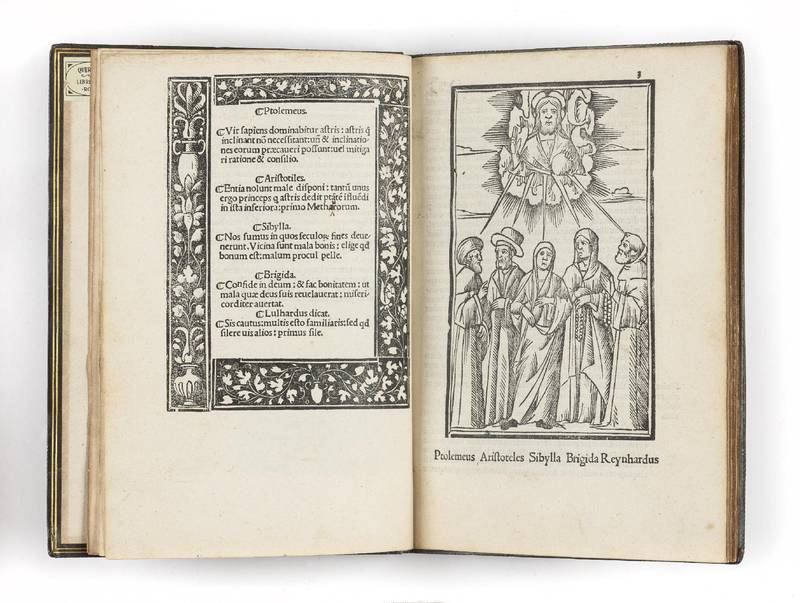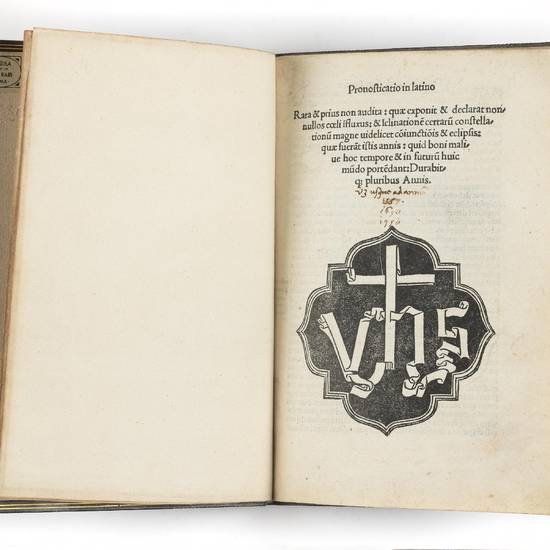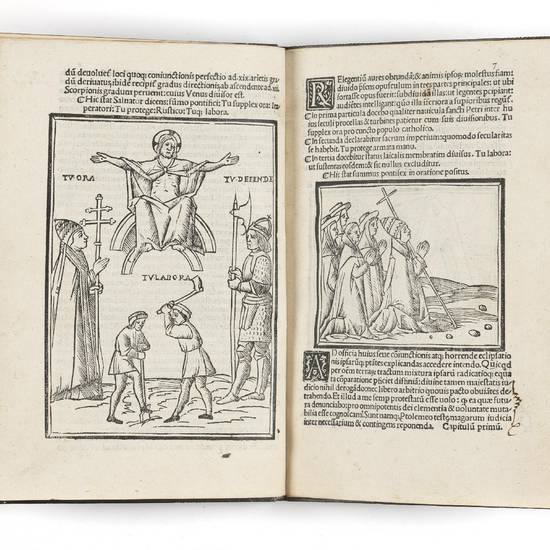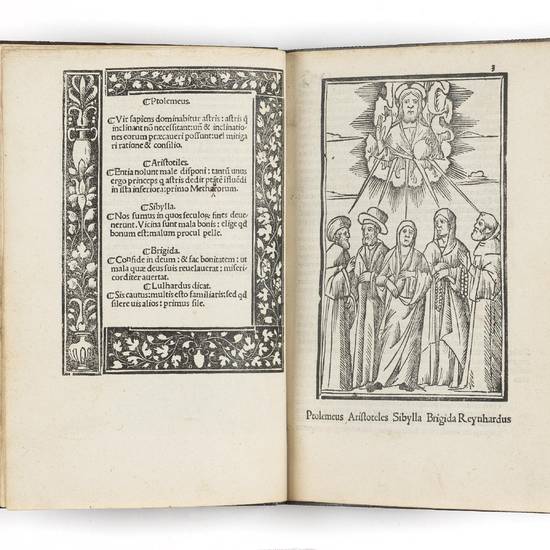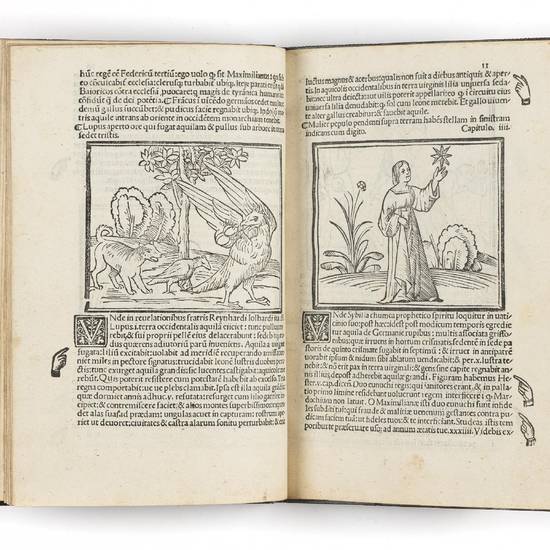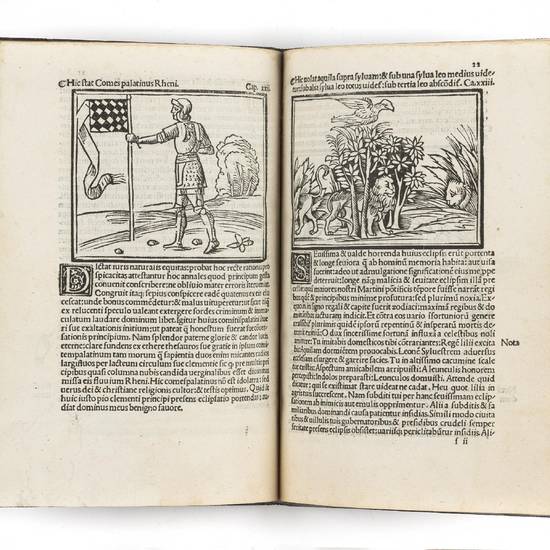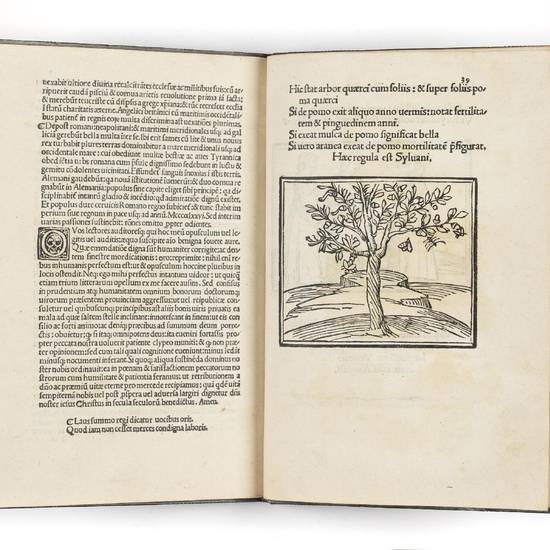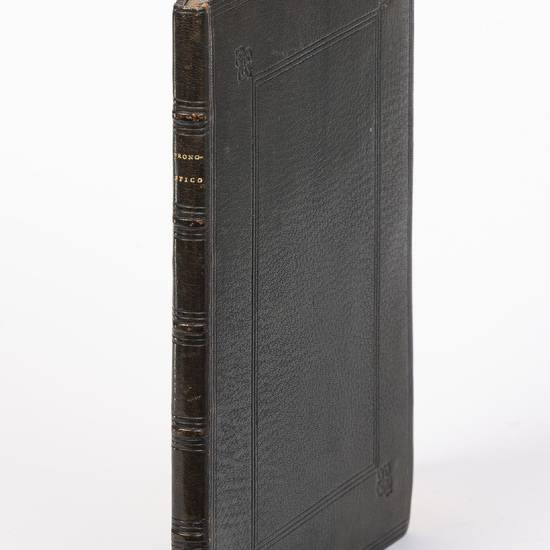Pronosticatio in latino rara & prius non audita: quae exponit & declarat nonnullos coeli influxus: & inclinationem certarum constellationum magne videlicet coniunctionis & eclipsis: quae fuerant istis annis: quid boni malive hoc tempore & in futurum huic mundo portendant: Durabitque pluribus annis
Autore: LICHTENBERGER, Johann (Johannes Grümbach, 1458-1510)
Tipografo: Niccolò e Domenico dal Gesù
Dati tipografici: Venezia, 23 agosto 1511
NICELY BOUND IN FULL MOROCCO
4to (208x144 mm). 39, [1] leaves. Collation: a-k4. Leaf k4 is a blank. Colophon at l. k3v. Printer's device on the title page with the monogram of Christ on black ground, woodcut border on black ground at l. a2, full-page woodcut at l. a3r showing Ptolomy, Aristotle, the Cumaean Sibyl, St. Bridget, and Reinhard the Lollard receiving prophetic inspiration from God Father, 42 smaller woodcut illustrations (one repeated), full-page woodcut illustration at l. b2v (copied from a block of the 1492 Modena edition), another full-page woodcut at l. d1r, numerous decorated initials and printed maniculae in the margins. Later green morocco gilt. On the front paste-down bookplate of the Libreria Querzola from Rome. A beautiful copy.
The illustrations are the same as in the vernacular edition (Pronosticatione in vulgare) that Niccolò and Domenico dal Gesù printed a few days earlier, on 9 August, of the same year. A third edition in the vernacular, but with the woodcuts in a reduced format, was published by the two brothers on 20 October 1511.
The Pronosticatio, a prophetic text printed for the first time in Germany in 1488 in two editions that appeared at the same time in Latin and German, arrived in Italy in the Latin version under unknown circumstances. It was soon after translated by an anonymous author allegedly around the time of the first known printing (Modena, Roccocciolo, 1490 or 1492). Overall, there are fourteen Italian editions of the Pronosticatio, printed between 1490-92 and 1532 in Venice, Milan, Modena and Brescia, with the majority of the editions issued in Venice and Modena.
“At the opening of the new century, when the work presented itself as a tempting forecast valid for the entire first half of the sixteenth century, at least three editions of the Pronosticatione in vulgare were printed in three different cities (Milan, Venice, and Brescia). A decade later, the Venetian workshop of the brothers Nicolò and Domenico del Gesù took over Lichtenberger's work, issuing three editions, one of which in Latin, in a single year (1511). The initiative seems to have come from an officer of the Serenissima, who was perhaps understandably interested in the political-military forecasts, especially in relations with the Turks, scattered throughout the pamphlet […] Between August and October, the brothers Nicolò and Domenico del Gesù, owners of the bookshop of the same name in the very central Mercerie near campo San Zulian, put their unmistakable typographic mark with the monogram of Christ on three editions, one of which was in Latin. The initiative, according to the contemporary testimony printed as an appendix to the Nicolò and Domenico del Gesù edition of 9 August 1511, was taken by a messer ‘Sabastian de Venetia constestabile della Illustrissima Signoria', i.e. a junior officer in the Serenissima's army, whose identity remains obscure […] So, in 1492 messer Sebastiano, who got to know Lichtenberger through one of the Modena incunabula editions, decided to publish the work also in Venice. However, for some reason that we ignore, the initiative was postponed for about twenty years and only in August 1511 he finally reached an agreement with the Del Gesù brothers, shrewd booksellers-publishers specialized in the production and sale of illustrated books and engraved prints […] In this operation the Del Gesù brothers presumably plaid the role of co-publishers rather than printers, as it does not appear that they had their own printing house, but used to turn to external workshops, mainly that of the Nicolini da Sabbio, who printed almost half of the thirty or so recorded editions ‘ad instantia de Nicolò e Domenego fratelli quali tien per insegna el Yesus'. It is almost certain though that their workshop was responsible for the production of the entire series of woodcuts, which for the occasion was remodelled on the Modena incunabula editions rather than on the German ones. In the series produced for the Del Gesù brothers there is a clear attempt to move away from the expressionistic emphasis of the German model to which the Modenese engraver was still somehow dependent. The rendering of physiognomic features, although simplified, is more natural, as is the positioning of the figures in the space, which captures more aspects of their interaction, revealing an awareness of contemporary Venetian narrative painting” (G. Petrella, La Pronosticatio di Johannes Lichtenberger. Un testo profetico nell'Italia del Rinascimento, Udine, 2010, pp. 13, 65-67, 70-71).
“The Pronosticatio is an astrological prophecy covering a long period of time, up to 1567. The text was conceived accompanied by a series of more than forty woodcuts - many of them with zoomorphic protagonists - which are present in almost all printed editions. In the sort of theoretical introduction to prophecy that Lichtenberger gives at the beginning of the work, he attributes the gift of clairvoyance to three factors: long life, and therefore experience; knowledge and mastery of astrological laws; revelation of God through the Holy Spirit. He does not discuss the question of free will, does not give physical or mathematical explanations, nor does he refer to scientific authorities of his time. The introduction is followed by a prayer, then by the actual beginning of the Pronosticatio, which opens with the announcement of the imminent horrendous conjunction of Saturn and Jupiter. The work is then divided into three parts, the first of which has three chapters (one admonition to the Pope, one to the whole of Christendom, one to the Empire), the second thirty-seven chapters (mostly containing interpretations of various previous prophecies by the Sibyls, Reinhard Lollard, Joachim of Fiore, St Bridget, Methodius, Daniel, etc., as well as references to historical events relating to the Kingdom of France and the Empire), and the third fourteen (consisting of a list of small prophecies about the fate of certain European cities, peoples and nations […]). What characterizes this text and makes it interesting for its contemporaries is that it refers heterogeneously to three subjects (and, in a sense, to three different groups of readers): the Pope (and with him the ecclesiastical hierarchies), the Emperor, and the secular world. It is thus easily understandable how and why this prophecy met with such a wide audience. The concept that Lichtenberger retains most from his readings and sources is that of the Joachimite renovatio” (M. del Savio, “Molte altre anchora profetie abiano veduto”. Alcuni testi profetici “intrusi” nell'unica copia manoscritta conosciuta della Pronosticazione del Lichtenberger, in: “Laboratoire italien [En ligne]”, 21, 2018).
Edit 16, CNCE63223; Essling, 1252; Sander, 3968; De Marinis, Il Castello di Monselice, p. 67; D. Fava, La fortuna del pronostico di Giovanni Lichtenberger in Italia nel Quattrocento, in: “Gutenberg Jahrbuch”, 23, 1930, pp. 133-138, no. 6; Petrella, no. 8; J. Green, Printing and Prophecy: Prognostication and Media Change 1450-1550, Ann Arbor (MI), 2012, pp. 43-55.
[10090]



